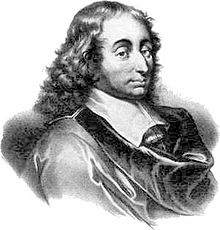Blaise Pascal
Born 1623, Rouen, France; died 1666, France; French mathematician and philosopher who invented an adding machine with automatic carry between digits, and the "Pascal Triangle" of coefficients of the binomial series; also the inventor of the wheelbarrow, the omnibus, and the roulette wheel. [From "Trivial Pursuit," original version.]

Son of a tax collector, Pascal was a child prodigy who discovered the proof of Euclid's 32nd Proposition at the age of 12: "La somme des angles d'un triangle quelconque est égale à deux angles driots." Four years later, he developed a fundamental theorem of projective geometry, such that the projections of the opposing sides of a hexagon inscribed in a conic section intersect to define a single line named the "droite de Pascal".
In assisting his father he became impressed by the need for a mechanical device for performing arithmetic operations and, in 1642, developed his adding (and subtracting) machine. The primary innovation of the calculator was its ability to automatically carry the "tens" digit from one position to the next.
During the next decade he built almost 50 copies of the machine, but most of them were used as parlor curiosities of their rich purchasers rather than working machines. After this period he returned to his studies of mathematics, and in 1654 presented two papers that form the basis of integral calculus and the theory of probability. In the same year he introduced his triangle of binomial coefficients-the Pascal Triangle-which predated the concepts of computation of the values of polynomial functions by differences.
Pascal Triangle
| 1 | 1 | 1 | 1 | 1 | 1 | 1 | 1 | 1 | 1 |
| 1 | 2 | 3 | 4 | 5 | 6 | 7 | 8 | 8 | |
| 1 | 3 | 6 | 10 | 15 | 21 | 28 | 36 | ||
| 1 | 4 | 10 | 20 | 35 | 70 | 126 | |||
| 1 | 5 | 15 | 35 | 70 | 126 | ||||
| 1 | 6 | 21 | 56 | 126 | |||||
| 1 | 7 | 28 | 84 | ||||||
| 1 | 8 | 36 | |||||||
| 1 | 9 |
The method of computation is quite simple. The first row and column consist simply of unit values. The entry in any interior cell is then simply the sum of the entry in the cell to the left and the cell above. The diagonal elements (top right to lower left) then constitute the coefficients of the polynomial (x + y)nwhere n + 1 is the index of the diagonal. Thus (x + y)4 can be read off from the 5th diagonal (in bold above):
x4+ 4x3 y + 6x2 y2 + 4xy3 + y4
The powers associated with the free variables x and y sum to n in each term and change monotonically.
In 1658 Pascal challenged his fellow mathematicians to a contest; he entered the contest himself under a pseudonym and when he awarded the prize to himself his colleagues were (perhaps justifiably) enraged.
QUOTATION
Je n'ai fait celle-çi plus longue que parceque je n'ai pas en le loisir de la faire plus corte. [I have made this letter longer than usual, because I lack the time to make it short.] (Lettres Provenriales, 1657)
BIBLIOGRAPHY
Biographical
Bishop, M., Pascal. The Life of a Genius, Bell & Sons, London, 1937.
Devaux, Pierre, "Cet Amateur de Genie: Pascal," Sciences et Avenir, No. 188, Paris, Oct. 1962, pp. 678-682.
Jones, C.V., "Pascal, Blaise," in Ralston, Anthony, and Edwin D. Reilly, Jr., Encyclopedia of Computer Science and Engineering, Van Nostrand Reinhold Co., New York, 1983.
UPDATES
Portrait added (MRW, 2013)
New content Copyright © 2013-2023 by the IEEE Computer Society and the Institute of Electrical and Electronics Engineers Inc.
All rights reserved. This material may not be reproduced or redistributed without the express written permission of the copyright holder.
